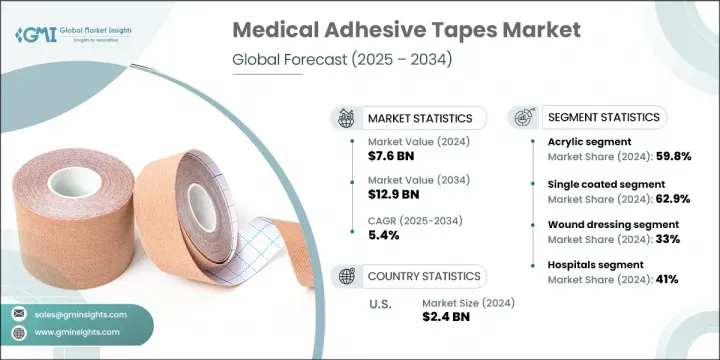
세계 의료용 접착 테이프 시장은 2024년 76억 달러로 평가되었으며 CAGR 5.4%로 성장하여 2034년에는 129억 달러에 이를 것으로 예측됩니다.
효율적인 상처 케어 솔루션에 대한 수요 증가는 만성 질환의 이환율 증가, 수술 개입 급증, 외상 관련 사례의 현저한 증가에 의해 크게 뒷받침되고 있습니다. 의료용 접착 테이프는 붕대, 드립 라인, 의료기기의 고정 등 현대 건강 관리에서 중요한 역할을 하며 신속한 상처 관리가 필요한 긴급 치료에 필수적입니다. 시장은 계속 진화하고 있으며 편안함, 피부 적합성 및 맞춤화가 더욱 중요해지고 있습니다.

제조업체 각 회사는 자극을 줄이고 치료 성적을 향상시키는 피부 친화적인 저자극성 고급 옵션을 개발합니다. 실리콘을 기반으로 한 생체 적합성 소재를 포함한 접착제의 혁신은 제품 표준을 재구성합니다. 환자 특화된 케어로의 전환은 구매 행동에 더욱 영향을 미치며, 감수성, 이동성, 상처 부위의 요인을 고려합니다. Flexcon Company, Paul Hartmann, Berry Global Group, Solventum, Lohmann GmbH와 같은 주요 기업들은 제품 혁신과 임상 효과를 우선시하여 시장 환경 형성에 기여하고 있습니다.
| 시장 범위 | |
|---|---|
| 시작 연도 | 2024년 |
| 예측 연도 | 2025-2034년 |
| 시작 금액 | 76억 달러 |
| 예측 금액 | 129억 달러 |
| CAGR | 5.4% |
2024년에는 아크릴 기반 의료용 접착 테이프가 59.8%의 점유율을 차지했습니다. 아크릴계 접착제의 매력은 통기성, 내열성, 내습성, 단기 및 장기 용도에 적합합니다. 아크릴계 접착제의 수증기 투과성은 피부 파괴의 위험을 줄이고 더 나은 치유 환경을 지원합니다. 이 편안함과 내구성의 균형은 상처 관리 및 수술 현장에서 사용하기에 이상적입니다.
2024년에는 싱글코트 테이프가 62.9%로 최대의 점유율을 차지하고, 그 용이한 도포와 다른 표면에의 일관된 점착성을 지지하고 있습니다. 이 테이프는 튜브 및 드레싱 재료의 고정에서 의료기기의 고정에 이르기까지 다양한 임상 응용 분야를 위해 설계되었으며 병원과 재택 간호 모두에서 현장에서 신뢰할 수 있는 옵션이 되었습니다. 통기성이 뛰어나 피부 친화적인 특성과 내습성을 겸비하여 환자의 취급을 보다 안전하고 신속하게 실시할 수 있습니다.
미국의 의료용 접착 테이프 시장은 2024년에 24억 달러를 창출했습니다. 이러한 이점은 첨단 건강 관리 인프라와 신뢰할 수 있는 상처 관리 제품에 대한 수요 증가로 인한 것입니다. 고령자 인구 증가나 당뇨병 등의 질환의 유병률의 증가가 사용량 증가의 주된 요인이 되고 있습니다. 이 나라의 광범위한 건강 관리 네트워크는 치유와 환자의 편안함을 향상시키는 고성능 테이프의 사용을 촉진하고 있습니다.
의료용 접착 테이프 시장에서 사업을 전개하는 기업은 그 지위를 강화하기 위해 다양한 성장 전략을 채택하고 있습니다. 각 회사는 연구 개발에 투자하고 다양한 피부 유형과 임상 요구에 맞는 보다 진보되고 피부에 안전하고 통기성이 있는 접착 솔루션을 개발하고 있습니다. 의료 제공자와의 제휴와 고성장 지역 진출로 제품의 도달범위가 향상되고 있습니다. 많은 기업들이 세계 수요 증가에 대응하기 위해 제조 능력과 공급망 확대에 주력하고 있습니다.
The Global Medical Adhesive Tapes Market was valued at USD 7.6 billion in 2024 and is estimated to grow at a CAGR of 5.4% to reach USD 12.9 billion by 2034. Rising demand for efficient wound care solutions is largely fueled by the growing incidence of chronic diseases, a surge in surgical interventions, and a notable increase in trauma-related cases. Medical adhesive tapes play a critical role in modern healthcare for securing bandages, IV lines, and medical devices, and are essential in emergency treatments requiring prompt wound management. The market continues to evolve, with greater emphasis on comfort, skin compatibility, and customization.

Manufacturers are developing advanced skin-friendly and hypoallergenic options that reduce irritation and improve healing outcomes. Innovations in adhesives, including silicone-based and biocompatible materials, are reshaping product standards. The shift toward patient-specific care further influences purchasing behavior, with sensitivity, mobility, and wound site factors considered. Major players such as Flexcon Company, Paul Hartmann, Berry Global Group, Solventum, and Lohmann GmbH are helping shape the market landscape by prioritizing product innovation and clinical efficacy.
| Market Scope | |
|---|---|
| Start Year | 2024 |
| Forecast Year | 2025-2034 |
| Start Value | $7.6 Billion |
| Forecast Value | $12.9 Billion |
| CAGR | 5.4% |
In 2024, the acrylic-based medical adhesive tapes accounted for a 59.8% share. Their appeal lies in their breathability, resistance to heat and moisture, and compatibility with both short-term and extended applications. The ability of acrylic adhesives to manage moisture vapor transmission helps reduce the risk of skin breakdown and supports better healing environments. This balance of comfort and durability makes them ideal for use in wound care and surgical settings.
The single-coated tapes held the largest share at 62.9% in 2024, favored for their easy application and consistent adhesion across different surfaces. These tapes are designed for a range of clinical uses, from securing tubing and dressings to medical devices, making them a reliable option in both hospital and home care settings. Their breathable and skin-friendly properties, combined with moisture resistance, allow for safer and quicker patient handling, which is critical in fast-paced care environments.
U.S. Medical Adhesive Tapes Market generated USD 2.4 billion in 2024. This dominance is driven by its advanced healthcare infrastructure and increasing demand for reliable wound care products. A growing elderly population and the high prevalence of conditions like diabetes are major contributors to rising usage. The country's extensive healthcare network continues to promote the use of high-performance tapes that offer enhanced healing and patient comfort.
Key companies actively involved in the Global Medical Adhesive Tapes Market include Johnson & Johnson, Smith & Nephew, Nitto Denko Corporation, McKesson Corporation, Dermarite Industries, Medline Industries, Medtronic, Avery Dennison Corporation, DermaMed Coatings Company, Nichiban, Lintec Corporation, and Cardinal Health. To strengthen their position, companies operating in the medical adhesive tapes market are adopting a variety of growth strategies. They are investing in R&D to engineer more advanced, skin-safe, and breathable adhesive solutions tailored to different skin types and clinical needs. Partnerships with healthcare providers and expansion into high-growth regions allow for improved product reach. Many are focusing on expanding manufacturing capabilities and supply chains to meet increasing global demand.
Industry pitfalls and challenges